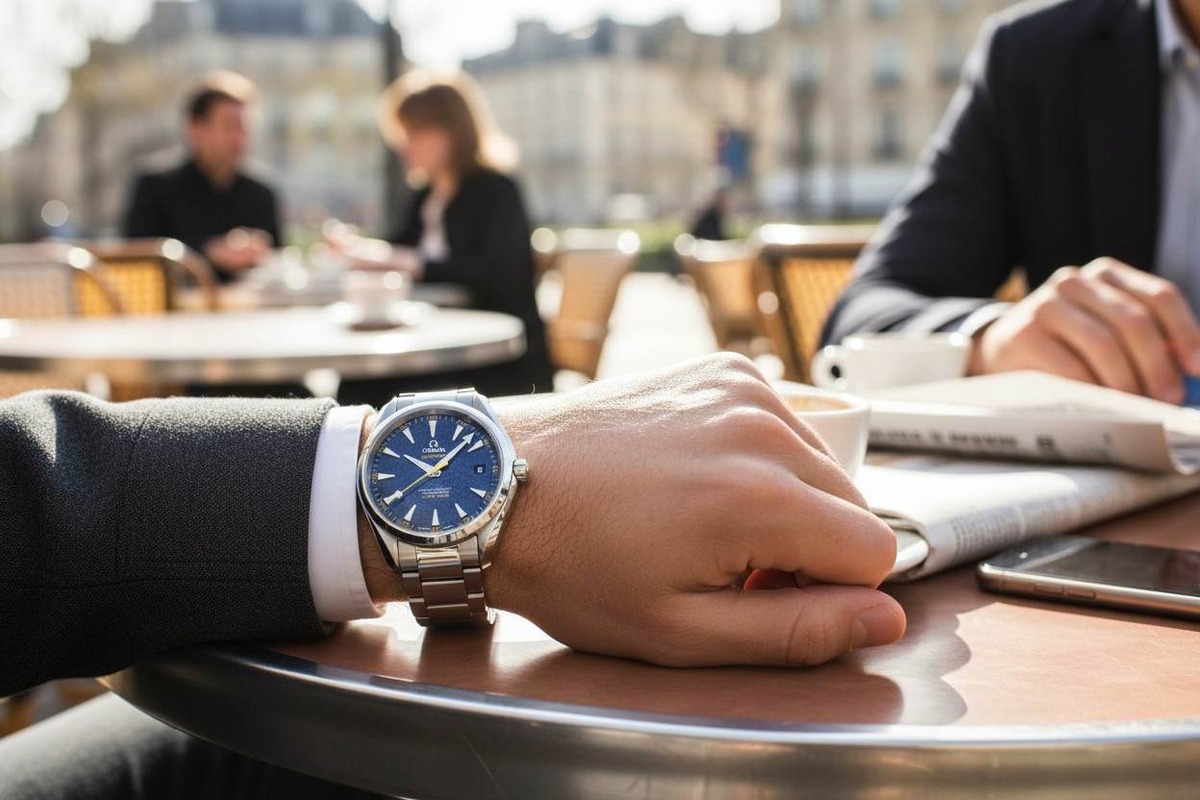Chronograph in a watch – what is it, how does it work, and what is it for?
Chronograph watches have been attracting attention for years not only with their appearance, but also with functionality. Although for many they're simply additional dials and buttons, in reality there's a precise time measurement tool behind them. If you're wondering what a chronograph is, how it works, and whether it's worth having one in your watch, this article will help you understand everything in a simple and practical way.
Chronograph watch – what it really is and whether you need it?
You don't have to be a watchmaking enthusiast to wonder what the presence of a chronograph in a watch actually means. The name sounds serious and might be associated with something technologically advanced, but in practice it's about a fairly simple, though extremely useful function. A chronograph in a watch is simply an analog stopwatch that allows you to measure specific time intervals – from seconds, through minutes, to entire hours. There's nothing magical here – you press START, count time, press STOP. Simple, right?
That's exactly why men's chronograph watches and women's appear both in sports collections and elegant lines. In everyday life you can use it while cooking, training, or even working. So if you're wondering whether such a mechanism is necessary for you – the answer is: maybe not essential, but definitely useful and practical. And it adds character – because totalizers and buttons on the case simply look good. A chronograph is not only functionality, but also aesthetics and detail that makes the watch become more "yours".
Victorinox Maverick Chronograph 241865 is an expressive Swiss Made watch that combines the sporty functionality of a chronograph with the elegance of a navy dial and classic leather strap.
Buttons, dials, hands – how to set a chronograph in a watch so it works properly
If you already have a chronograph watch, sooner or later there will come a moment when something stops adding up – the hand won't return to zero, the dial will be slightly shifted, and the stopwatch function won't work as it should. And then you start searching to make everything work properly again. Fortunately, most models operate intuitively – though it's worth knowing a few rules so as not to damage the mechanism.
Typically you have two buttons: the upper one starts and stops measurement, the lower one resets the hands. If the watch works correctly, that's enough. But if something got misaligned – you need to perform calibration. Just pull the crown to the first position, then – using the buttons – set each hand exactly to the "zero" position, which is at 12:00. When everything is in place, push the crown back and you're done. Seemingly simple, but if you don't know this procedure, it's easy to get confused – or worse, press something too hard. That's why it's worth acting calmly and, if you have the opportunity, check the specific manufacturer's recommendations.
What is a chronograph in a watch for? You'll be surprised how often it can be useful
For many people a chronograph is simply a "nice addition" – a few dials, buttons, maybe some technical appearance. But when you start using it, it quickly turns out that it's one of the more practical functions in a classic women's watch and men's. You can use it to measure training interval times, count cooking minutes, or check how long your daily commute to work takes. And no – you don't need a smartwatch or phone app for this. You have it all at hand.
Edox La Passion Chronograph 10220 357RC AR is a refined Swiss Made women's watch that combines the elegance of Roman indices with chronograph functionality and luxurious rose gold finish.
Men's chronograph watches are often chosen by active people who like to have everything under control. Lap time, break between sets at the gym, and even a simple test of how long it takes to leave the house in the morning – it can all be handled with one click. On the other hand, women's chronograph watches increasingly appear in lifestyle collections, where functionality combines with minimalist design. Here the chronograph not only works, but also looks great. So if you're looking for something more in a watch than just telling time, a chronograph is a function you can really use on a daily basis.
Not every chronograph works the same way – learn the types and decide which suits you
When you first hear about chronographs, it seems like it's simply a stopwatch – it works or it doesn't. But the truth is that there are several different types of chronographs that differ not only in how they operate, but also in capabilities. And it's often these differences that determine whether a given watch will suit you and your needs.
The simplest is a quartz chronograph, found in many affordable models. It works accurately, is easy to set, and practically requires no technical knowledge. On the other hand, a mechanical chronograph is already higher level – based on precise construction, often controlled by a column wheel, with beautifully working hands and characteristic "click" when starting. If you care about user experience, this might be something for you.
There are also more advanced constructions, like flyback (quick reset and immediate resumption of measurement) or rattrapante, enabling split-time measurement. These are already high-end solutions, often found in aviation watches or luxury models. So if you're considering a purchase – it's worth knowing what's hidden under that small button next to the crown. A chronograph in a watch can be simple or advanced – the important thing is that it's matched to your lifestyle.
Citizen Promaster Sky CB5860-86E is a technologically advanced watch for demanding users, light-powered thanks to Eco-Drive technology, radio-controlled and water-resistant to 200 meters.
A chronograph is not a chronometer – don't be misled by similar names
This is one of those mistakes that happen really often. You see a watch description where someone writes about a "chronometer" and shows a model with additional dials and a stopwatch. The problem is that a chronograph and chronometer are completely different things, despite their names sounding similar. And it's good to know the difference if you want to consciously choose a watch that truly meets your expectations.
A chronograph in a watch is a stopwatch function that allows you to measure time intervals using additional hands and buttons. It has nothing to do with movement accuracy – it's simply additional functionality. A chronometer, however, is a watch that has passed rigorous precision tests, usually according to COSC standards (in the case of Switzerland). Such a model receives a certificate confirming its exceptional accuracy.
Interestingly – one watch can have both features simultaneously. You can find a model that is both a chronograph and chronometer, but these are still two different concepts. Therefore, before you decide on a specific purchase, it's worth carefully reading the specifications. In the online watch store WestWatches you'll find a wide selection of watches with accurate technical descriptions that will help you choose the model best suited to your needs and expectations.
See popular articles

What was the first watch in space? Find out what astronauts wear on their wrists
Did you know that the first watch that flew into space wasn't on a human wrist, but... attached to a dog's leg? The history of timepieces in space is a fascinating story of technological rivalry, astronaut courage, and extraordinary precision that could save lives. From the Soviet Pobeda and Gagarin's Sturmanskie to the legendary Omega Speedmaster, which passed NASA's most brutal tests – each of these watches became part of space exploration history. Discover what astronauts actually wear on their wrists and why even today, in the smartwatch era, they still choose mechanical legends.

What is GMT time and how can you use this function on your watch?
Not every watch shows only one time – some can do much more. The GMT function allows you to track the time in two or even three time zones simultaneously, making it ideal for travellers, pilots and people working internationally. But before you learn how it works and what the GMT time zone actually is, it's worth learning about its history – from Greenwich, London, to modern watches with the most advanced mechanisms.

Dlaczego zmieniamy czas na zimowy w zegarkach? Tłumaczymy mechanizm i historię zmiany czasu
Dwa razy w roku cofamy lub przesuwamy wskazówki zegara, ale rzadko zastanawiasz się, po co właściwie jest zmiana czasu i dlaczego wciąż jej przestrzegamy. To nie tylko kwestia tradycji – za tym zwyczajem stoi historia, decyzje polityczne i próba lepszego wykorzystania światła dziennego. Sprawdź, jak działa mechanizm przestawienia czasu, skąd się wziął i jakie ma znaczenie dziś.

Zegarki solarne - ranking ciekawych modeli i wszystko co warto wiedzieć przed zakupem
Zegarki solarne to nowoczesne połączenie stylu i praktyczności – zasilane światłem, niezawodne i przyjazne środowisku. Dzięki wbudowanym panelom solarnym nie wymagają regularnej wymiany baterii, co czyni je wyjątkowo wygodnymi w codziennym użytkowaniu i bardziej ekologicznymi. W naszym rankingu znajdziesz modele, które wyróżniają się nie tylko atrakcyjnym designem, ale również bogatą funkcjonalnością i imponującą trwałością, idealne dla wymagających użytkowników poszukujących zegarka na lata.

Jak zmienić czas na zimowy w Casio G Shock?
Zmiana czasu potrafi zamieszać – nie tylko w głowie, ale i na nadgarstku. Jeśli nosisz G-Shocka i chcesz szybko przestawić go na czas zimowy, nie musisz zagłębiać się w instrukcje ani zgadywać, który przycisk za co odpowiada. W tym poradniku znajdziesz konkretne wskazówki, proste kroki i sprawdzone triki, które pomogą Ci bez nerwów ustawić zegarek Casio G-Shock – niezależnie od modelu, który masz.

Jak dobrać biżuterię do zegarka? Zasady, inspiracje i gotowe triki stylizacyjne
Dobranie biżuterii do zegarka to nie tylko kwestia gustu, ale przede wszystkim umiejętność stworzenia spójnej, stylowej całości. Zegarek może być subtelnym tłem dla dodatków albo główną ozdobą, wokół której budujesz cały look. Sprawdź, jak łączyć metale, wybierać bransoletki i tworzyć zestawienia, które zawsze wyglądają elegancko i nowocześnie.

Jaki zegarek na 40 urodziny wybrać? TOP 5 wyborów
Czterdzieste urodziny to wyjątkowy moment – symboliczny etap życia, w którym zegarek może stać się nie tylko praktycznym dodatkiem, ale także wyrazem stylu, statusu i osobowości. Zegarek na 40 urodziny powinien podkreślać dojrzały gust, elegancję oraz indywidualność obdarowanego – kluczowe znaczenie ma jakość, prestiż marki oraz funkcjonalność dopasowana do codziennych aktywności Poniżej przedstawiamy TOP 5 zegarków męskich na 40 urodziny dostępnych w ofercie sklepu WestWatches – zapraszamy!

Jaki zegarek kupić na dzień chłopaka? TOP 6 propozycji od West Watches
Dzień Chłopaka to świetna okazja, aby podarować coś wyjątkowego – prezent, który będzie nie tylko praktyczny, ale i symboliczny. Zegarek to zawsze trafiony wybór – elegancki, funkcjonalny i trwały. Ważne jednak, by dopasować go do stylu oraz trybu życia obdarowywanego. Czy woli klasyczną elegancję, sportowy look, a może nowoczesne technologie? Poniżej znajdziesz sześć propozycji z oferty WestWatches.pl, które sprawdzą się jako idealny prezent.

Czym jest bezel zegarka? Wyjaśniamy jego zastosowanie i zalety
Bezel to detal, który często umyka uwadze, a w rzeczywistości decyduje o funkcjonalności, stylu i bezpieczeństwie zegarka. To właśnie ten pierścień sprawia, że czasomierz staje się czymś więcej niż tylko ozdobą na nadgarstku. Dowiedz się, co to jest bezel w zegarku, jak działa i do czego możesz go wykorzystać na co dzień.











